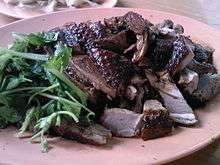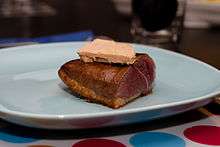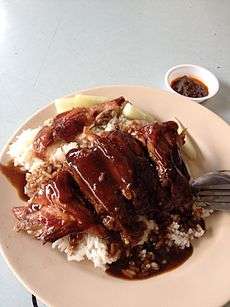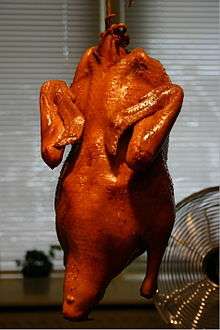Duck as food
In food terminology, duck or duckling (when meat comes from a juvenile duck) refers to duck meat, the meat of several species of bird in the family Anatidae, found in both fresh and salt water. One species of freshwater duck, the mallard, has been domesticated and is a common livestock bird in many cultures. Duck is eaten in various cuisines around the world.

Magret refers specifically to the breast of a mulard or Muscovy (or Barbary) duck that has been force fed to produce foie gras.[1]
Duck meat
Duck meat is derived primarily from the breasts and legs of ducks. Like all poultry meat, the meat is categorically classed as white meat despite the colour being slightly darker than normal poultry. The meat of the legs is darker and somewhat fattier than the meat of the breasts, although the breast meat is darker than the breast meat of a chicken or a turkey. Being waterfowl, ducks have a layer of heat-insulating subcutaneous fat between the skin and the meat.

De-boned duck breast can be grilled like steak, usually leaving the skin and fat on. Internal organs such as heart and kidneys may also be eaten; the liver in particular is often used as a substitute for goose liver in foie gras.
Duck is particularly predominant in the Chinese cuisine—a popular dish is Peking duck, which is made from the Pekin duck. Duck meat is commonly eaten with scallions, cucumbers and hoisin sauce wrapped in a small spring pancake made of flour and water or a soft, risen bun known as gua bao.
The Pekin duck is also the most common duck meat consumed in the United States, and according to the USDA, nearly 26 million ducks were eaten in the U.S. in 2004. Because most commercially raised Pekins come from Long Island, New York, Pekins are also sometimes called "Long Island" ducks, despite being of Chinese origin. Some specialty breeds have become more popular in recent years, notably the Muscovy duck, and the mulard duck (a sterile hybrid of Pekins and Muscovies).[2] Unlike most other domesticated ducks, Muscovy ducks are not descended from mallards.
Nutrition
Duck meat is notoriously very high in cholesterol and fat, particularly saturated fat, and may not be a good choice for those at risk of heart disease. However, it is also very high in protein and iron[3] and is generally nutritious and filling for those who can tolerate the high fat content. Slow cooking using methods of cooking which allow drainage of the grease can partially alleviate the high fat content, though duck meat will always be a high-fat food.
Duck dishes
Duck is used in a variety of dishes around the world, most of which involve roasting for at least part of the cooking process to aid in crisping the skin. Some dishes use parts of the duck as an ingredient along with other ingredients. Notable duck dishes include:
- Ballotine
- Balut is a developing bird embryo boiled and eaten from the shell. It is sold as street-food in the Philippines and around Southeast Asia.[4]
- Bebek Betutu – a famous traditional dish from Bali, Indonesia. The duck is first seasoned with pungent roots and various herbs, wrapped with banana leaves, and roasted. Chicken is also used to prepare Betutu.
- Chicken and duck blood soup
- Duck blood and vermicelli soup
- Duck confit – duck legs that have been cured (partly or fully) in salt, then marinated and poached in duck fat, typically with garlic and other herbs. The French word confit means "preserved", and the French name for duck confit is "confit de canard".
- Czernina – a sweet and sour Polish soup made of duck blood and clear poultry broth. It was once considered a symbol of Polish culture until the 19th century, customarily served to young men and is even featured as a plot device in a famous epic poem called Pan Tadeusz.
- Duck à l'orange – a classic French dish in which the duck is roasted and served with an orange sauce.
- Duck rice – A traditional Singaporean dish made of roast duck and white rice
- Duck Bamboo Curry – a traditional dish of Sylhet region
- Foie gras – a specially fattened and rich liver, or a pâté made from the liver, sometimes taken from a goose but usually from a duck.
- Long Island roast duckling – this is a whole roasted bird, sometimes brined previously. When done properly, most of the fat melts off during the cooking process, leaving a crispy skin and well-done meat. Some restaurants on Long Island serve this dish with a cherry sauce.
- Guyanese duck curry[5]
- Kamo nabe – duck hot pot
- Kamo Nanban – soba or udon with duck meat and leeks
- Lemon duck
- Nanjing Salted Duck
- Oritang – a variety of guk, Korean soup made with duck and various vegetables.[6]
- Peking duck – a famous Chinese dish originating from Beijing, prepared since the Ming Dynasty era. It is prized for the thin, crispy skin, with authentic versions of the dish serving mostly the skin and little meat, and eaten with pancakes, scallions, and hoisin sauce or sweet bean sauce.
- Pressed duck – a complex dish originally from Rouen, France.
- Rouennaise sauce – prepared using puréed duck liver as an ingredient
- Tiết canh
- Turducken: an American dish that comprises a turkey, stuffed with a duck, which is in turn stuffed with a chicken.
- Wuhan duck
- Yuhwang ori
- Zhangcha duck – a quintessential dish of Sichuan cuisine. It is first prepared by smoking a marinated duck over tea leaves and twigs of the camphor plant, then steamed, and finally deep fried for a crisp finish. Also called tea-smoked duck.
Pollution contaminating wild duck
Ducks caught in the wild may be contaminated from pollution of rivers and other bodies of water, because they eat fish and other aquatic life. In particular, PCBs may pose a health risk for those who eat wild duck frequently.[7]
References
- "Magret definition". Cdkitchen.com. Retrieved 6 February 2012.
- "Domestic Ducks". Duckhealth.com. Archived from the original on 15 October 2013. Retrieved 6 February 2012.
- "Nutritionix - Duck, domesticated, meat only, cooked, roasted - 0.5 duck".
- Regional names.
- Bibi Sazieda Jabar (2011). Guyanese Style Cooking. iUniverse. p. 84. ISBN 978-1-4620-6336-9.
- 오리탕 (in Korean). Doosan Encyclopedia. Archived from the original on 9 December 2012.
- Faber, Harold (8 October 1981). "HUNTERS WHO EAT DUCKS WARNED ON PCB HAZARD". The New York Times.
Further reading
- Rombauer, Irma S., et al. Joy of Cooking, Scribner, 1997. ISBN 0-684-81870-1.
External links
| Wikimedia Commons has media related to duck meat. |
| Wikimedia Commons has media related to duck dishes. |
| Wikimedia Commons has media related to duck eggs. |
| Wikibooks Cookbook has a recipe/module on |



